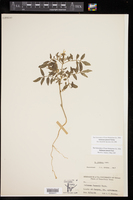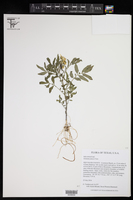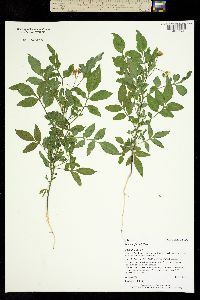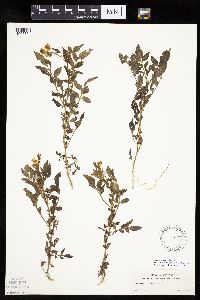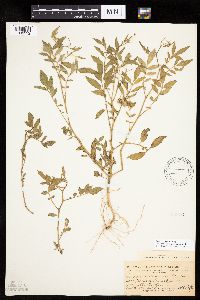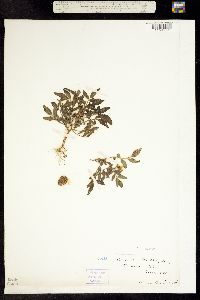Solanum jamesii
|
|
|
|
Family: Solanaceae
Wild Potato
[Solanum jamesii var. heterotrichium Bitter] |
Perennial herb, 10-30(50) cm tall, glabrous to pilose and somewhat glandular, with rhizomes bearing tubers about (5)10-15(20) mm in diameter LEAVES: odd-pinnate, alternate, 7-15cm long, 4-9 cm wide; upper surface glabrous or nearly so; lower surface with short glandular pubescence; leaflets (5)7-9(13), linear-oblong to lanceolate, (0.5)2.5-5.0(6.0) cm long, 0.5-2.5(3.0) cm wide, usually 2-3x longer than wide, lanceolate to elliptic-lanceolate, lower most leaflets much reduced, rarely with small interstitial leaflets interposed between the larger ones; petioles up to 3cm long. INFLORESCENCE: lateral or pseudoterminal on leafy branches, few to several-flowered, ebracteate, paniculate cyme; peduncle 1-6 cm; pedicels 1-3 cm long. FLOWERS: 5-merous, bisexual, actinomorphic; calyx enlarged somewhat but not investing the fruit, up to 6 mm long, irregularly lobed to about the middle; lobes triangular-ovate to lanceolate, acute to acuminate; corolla white, 2.8-3.5 cm in diameter, stellate, lobed for one-third or more to base; lobes 8-16 mm long, ovate-lanceolate to triangular-laneolate, subobtuse to subacuminate, pubescent above middle on lobe tips; anthers yellow, lanceolate in outline, 4.5-7.0 mm long; filaments 1-4 mm long; style 10-14 mm long, much exceeding the stamens; stigma globose. FRUIT: spherical berries, slightly less than 1 cm in diameter, green throughout. n = 12. [Solanum jamesii var. heterotrichium Bitter, Solanum jamesii var. sinclairii Bitter & Correvon, Solanum jamesii subsp. septentrionale Bitter] -- grasslands, juniper-pinyon scrub deserts, oak thickets, coniferous and deciduous forests; mid July to early Oct; Apache, Cochise, Coconino, Greenlee, Mohave, Navajo, Pima, Santa Cruz, Yavapi cos. (Fig X); 1500-2600 m (5000-8500 ft). AZ, CO, TX, UT, and n Mex. A close relative to the cultivated potato; tubers have been reportedly used as a food source by some Native American tribes. This plant is highly variable and has been separated into several varieties by some authors. This treatment considers the complex to be a single variable species. REFERENCES: Scott T. Bates, Frank Farruggia, Edward Gilbert, Raul Gutierrez, Darin Jenke, Elizabeth Makings, Erin Manton, Douglas Newton, and Leslie R. Landrum. Vascular Plants of Arizona: Solanaceae Part Two: Key to the genera and Solanum. CANOTIA 5(1):1-16 Bates et al. 2009, Kearney and Peebles 1969, McDougal 1973 Duration: Perennial Nativity: Native Lifeform: Forb/Herb General: Herbaceous perennials to 45 cm tall, stems erect to spreading, herbage unarmed, glabrous to pilose or somewhat glandular, plants with rhizomes bearing tubers 10-15 mm in diameter. Leaves: Alternate, pinnate with 5-9 leaflets, 7-15 cm long, 4-9 cm wide, leaflets 5-13, lanceolate-oblong, 0.5-6 cm long, 0.5-3 cm wide, lower leaflets sometimes reduced, margins entire or nearly so, upper surface glabrous or nearly so, lower surface with short glandular pubescence. Flowers: White, actinomorphic (star-shaped), 5-angled or lobed, 3-3.5 cm in diameter, lobed for one-third or more to base, lobes 8-16 mm long, ovate-lanceolate to triangular-lanceolate, pubescent at the tips, calyx rotate to campanulate, to 6 mm long, lobes triangular-ovate to lanceolate, enlarged but not enclosing fruit, stamens 5, inserted on corolla tube, filaments short, style 10-14 mm long, much exceeding stamens, stigmas globose, flowers sometimes nodding, borne in few to several-flowered cymes, inflorescences leafy, branching or pseudoterminal at branch tips. Fruits: Leathery to juicy spherical berries slightly less than 1 cm in diameter, green throughout, not closely invested by the calyx. Ecology: Found in grasslands, juniper-pi-on scrub deserts, oak thickets, coniferous and deciduous forests, from 5,500-8,500 ft (1676-2591 m); flowering July-October. Distribution: Colorado, Utah, Texas, Arizona; Mexico. Ethnobotany: This plant was primarily used for food; the unpeeled potatoes were boiled and eaten, used to make yeast, or mixed with white clay to remove the astringent effect on the mouth and eaten like mush. Synonyms: None Editor: LCrumbacher 2011 Etymology: Solanum is Latin for "quieting," in reference to the narcotic properties of some species, while jamesii is named after Dr. Frederick C. James (1935-2002). Tuberiferous perennial, 1-4 dm; lvs pinnately compound, the lateral lfls lanceolate, sessile or short-stalked, not alternating with smaller ones; cor-lobes lance- triangular; 2n=24. Native of w. U.S., reported to be established in Io. Gleason, Henry A. & Cronquist, Arthur J. 1991. Manual of vascular plants of northeastern United States and adjacent Canada. lxxv + 910 pp. ©The New York Botanical Garden. All rights reserved. Used by permission. |
|
|
|


































